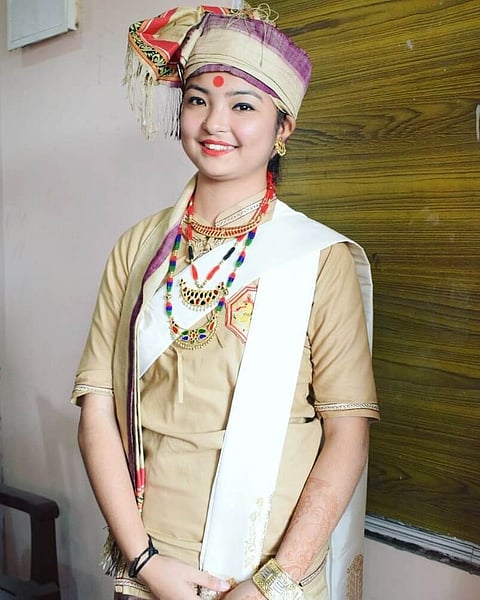
- Home
- Live Blog
- Breaking News
- Top Headlines
- Cities
- NE News
- Sentinel Media
- Sports
- Education
- Jobs

The Ahom age is the age of ornaments and attires of several types. For every class of people particular dresses and jewellery were being assigned and therefore, it is through the appearance of a person only, one could be identified without any difficulty. The dresses that were worn by the king or by the higher officials of the Ahom kingdom were not worn by a subject. For male and female both the genders, different varieties of dresses were available. Today I am here to take you to that age, the age of the Ahoms where you can see the royal behaviours, the royal costume senses and also the way of the styling of people of that time.
In the early years of the Ahom rule in Assam, the Ahoms were seen to wear black clothes and it was only later on that they switched to the white coloured clothes. As I said earlier, the dresses and ornaments depicted the class of a person of that time and that was displayed better by the turban and a kind of scarf, which is known as the ‘Seleng Sadar’. The higher officials, queens, princesses and the King used to drape turbans made of silk (pat-muga) in their head. Certain attires that were quite widely used and worn by the higher officials and also by some classes of the subjects are ‘Riha’ (a kind of cloth draped around the body and the shoulder), ‘Mekhela’ (a wrapper kind of cloth worn in the waist) and ‘Sula –Suria’ (a kind of short shirts and clothes made of Assam silks like Golden Muga, White Pat and Eri Silk) etc. So, whatever, they used to wear basically were made of Golden Muga, Pat and Eri silk only. ‘Majankari’ and ‘Sopapotia kapur’ are also certain other types of clothes which are being considered to be the best of the best and were worn by the Kings, Queens (Kuwaris) or other higher officials in special occasions only. It is since that golden age of handmade silk, Assam till now is carrying its glory of being the uncrowned monarch in the silk industry.
Now let’s have a look at the particular type of dresses that were worn by the Ahoms. The females of the Ahom kingdom did not have to keep themselves under veils. Instead of that, they had to wear ‘Seleng Sadar’ in their heads like a turban and wore ‘Sula’ (a kind of one piece attire). Day by day these types of clothing changed and the Ahom females started wearing the ‘Mekhela Sadar’ made of Pat and Muga. Males used to wear ‘Suria’ (clothes covering from the waistline) and ‘Suti Sula’ (short shirts) and tied ‘Basual Tongali” (a kind of belt type strap) on their waist. These clothes were worn by both male and females of Ahom kingdom but the only difference was that based on the class of people, the materials and designs of these things varied.
After the dresses of the Ahoms, now comes the detail about the jewellery and ornaments worn by them. The Ahoms were known for gold jewellery. They were rich in gold and hence, you can see them wearing heavy jewellery made of gold only. As gold was the recognition of the wealthy and royal families of Ahoms similarly, the people from lower strata used to wear jewellery made of silver and bronze. However, some other poor natives wore brass-made ornaments too. Male and female, all used to wear various types of ornaments on various occasions but as it is very obvious, the females used to be ornamented more than the males. The jewellery carried by the males were finger rings, ‘Hilikhamoni’ and ‘Motamoni’ (kind of chains worn around the neck), ‘Koriya’ and ‘Lukapar’ (earrings) and ‘Baju’ (an armlet).